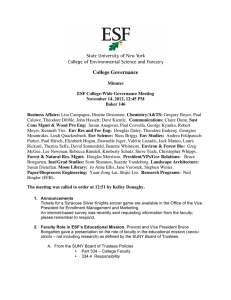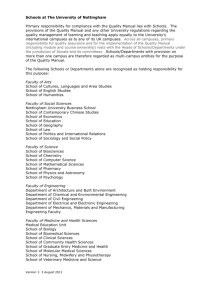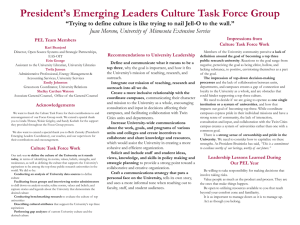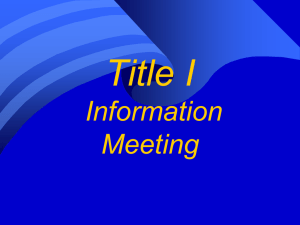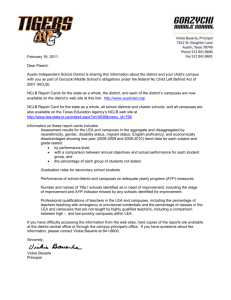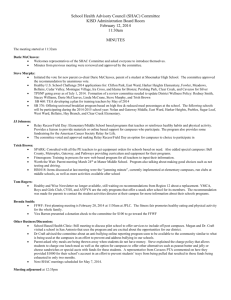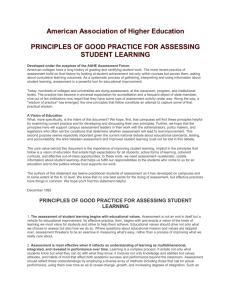Powerpoint
advertisement
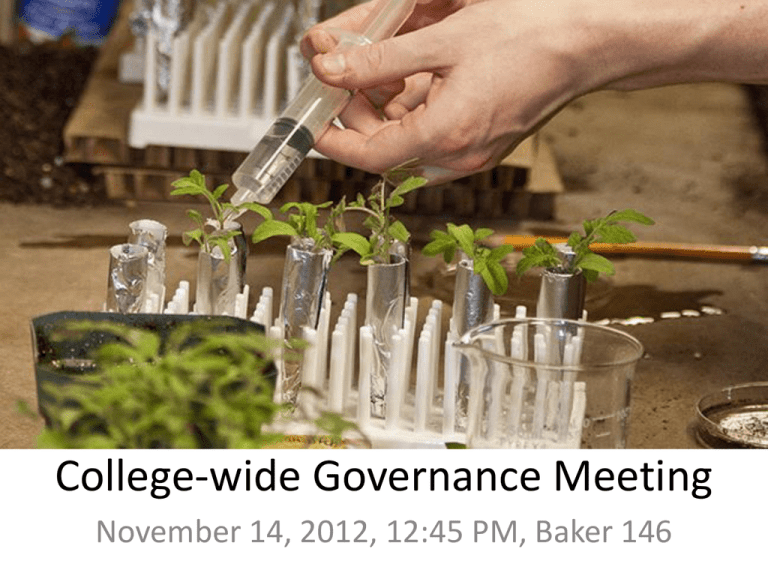
College-wide Governance Meeting November 14, 2012, 12:45 PM, Baker 146 Agenda 1. Announcements 2. Faculty Role in ESF’s Educational Mission (Bongarten) 3. IQAS Committee Report (Crovella) 4. University Faculty Senate Plenary (Campagna/Donaghy) 5. Syracuse University Senate Update (Donaghy/Weiter) IQAS Committee Report 2011-2012 2011-12 members –Faculty Members: Paul Crovella (chair), Biljana Bujanovic, Charles A. Hall, Nasri AbdelAziz, James M. Sahn, Kavya Krishna (student), Richard Smardon, Siddarth G. Chatterjee, James Williamson 2012-13 members - Faculty Members: Paul Crovella (chair),Paul Caluwe, Susan Dieterlen, Charles A. Hall, Nasri Abdel-Aziz, James M. Sahn, Aislinn Brackman(student),PJ Connell (student), James Williamson End-of-course surveys • Concern -Ongoing low participation rate • Two resolutions were passed and implemented 1. longer period of time for students to respond, and real-time tracking for participation. 2. EFB and Chemistry delivered paper format during class (In response to results from a faculty survey) • Result 1. Participation from to 2. Paper format will not continue ESF Foundation Teaching Award – • Concerns 1. Limited degree of student involvement in the nomination and selection process 2. Relatively low number of nominations in recent years • Resolution passed and implemented 1. Allowing for groups of students to initiate nominations, 2. Incorporation of both undergraduate and graduate representatives on the selection committee • Result The selection committee had three nominations to review. Academic Standards • Academic Review of Suspension Appeals – Fall: 19 suspensions, 9 appeals, 3 appeals accepted, 6 suspensions sustained – Spring: 35 suspensions, 14 appeals, 6 appeals accepted, 8 suspensions sustained • One grievance considered, One grievance adjudicated Existing Procedure 2012-13 academic year • Grievance procedure – The process for handling an academic grievance is being reviewed - from definition to resolution. Academic Grievance End of semester following semester of occurrence Informal Review Request for Formal Review 10 days Appeal 10 days Appeal 10 days Satisfactory and mutually agreeable resolution 10 days Formal Review Subcom of IQAS Recommendation 10 days Appeal of Formal Review IQAS Recommendation Accepted 10 days Final Decision President Resolved The day will come….. • • • • Delivery of end-of-course surveys Survey questions Teaching Center Charlie’s talk THE ROLE OF THE FACULTY IN THE COLLEGE EDUCATIONAL MISSION • From the SUNY Board of Trustees Policies • Part 334 – College Faculty • 334.4 Responsibility • The faculty of each college shall have the obligation to participate significantly in the initiation, development, and implementation of the educational program. THE ROLE OF THE FACULTY IN THE COLLEGE EDUCATIONAL MISSION • Elements • • • • • Delivery of instruction Student advisement Curriculum development Curriculum assessment Academic policy development THE ROLE OF THE FACULTY IN THE COLLEGE EDUCATIONAL MISSION • Extensions • A group of faculty must be identified to fulfill responsibilities. • Typically departmental faculty assume responsibility for instruction, advisement, curriculum development and assessment • Typically, the entire college faculty have responsibility for academic policy development • Programs are “owned” by the responsible faculty as a group. • Learning outcomes for required courses are set by and assessed by the faculty group. • Scheduling of required courses is determined by the group to meet programmatic objectives. THE ROLE OF THE FACULTY IN THE COLLEGE EDUCATIONAL MISSION • Whole faculty responsibilities • Development of academic policies • Curriculum • Standards • Curriculum review • Programmatic review • • • • Quality; meeting college standards Coordination Need: redundancy Cost efficiency • Course reviews • Quality; meeting college standards • Redundancy • Cost efficiency THE ROLE OF THE FACULTY IN THE COLLEGE EDUCATIONAL MISSION • “Departmental” faculty responsibilities • Development of curricular programs • Assessment and revision of curricular programs • Course scheduling to facilitate timely completion of degrees • Student advisement • Allowing variances in student programs THE ROLE OF THE FACULTY IN THE COLLEGE EDUCATIONAL MISSION • Administration Responsibilities • Academic policies • Provided guidance in policy development • Communicate policies • Execute/enforce policies • Curriculum development • Assure compliance with college policies • Determine availability of resources • Advisement and course scheduling • Provide guidance to faculty on policies and best practices • Execute administrative tasks • Assure compliance with college policies • Assessment • Coordinate and provide guidance to faculty • Assure compliance with College, SUNY and Middle States policies and standards • Prepare institutional reports on assessment • General • Execute tasks necessary to operate an academic enterprise in accordance with prescribed policies • Provide guidance in to faculty in fulfillment of their tasks • Assure that the interests of the College as a whole are not compromised by individual desires University Faculty Senate • SUNY – Oswego – 10/25-27 University Faculty Senate • • • • Budget Seamless Transfer Shared Services Necessity for Campus Presidents Sector New Tool Impact Mitigating Impact Research Centers/Other Doctoral • Transitional Funding to be provided or received in years 1-3, additional funding options for Downstate Explored • • Overall Increases in State Support of 1.8% ($10.0 M) Increases • 3 campuses • Largest increases of 11.0 % Decreases • 5 campuses • Largest decreases of 18.6% Comprehensives • Overall Decreases in State Support of ~4.0% ($7.1 M) • Increases • 3 campuses • Largest Increase 5.2% • Decreases • 10 campuses • Largest decrease of 21.6% Transitional funding to be provided in years 1-3. Technology • Transitional funding to be provided in years 1-3. • • Overall Decreases in State Support of ~4.3% ($2.7M) Increases • 3 campuses • Largest increase 13.2% Decreases • 5 campuses • Largest decrease 27% Research Sector Sector New Tool Impact Research • Overall Increases in State Centers/Oth Support of 1.8% ($10.0 M) er Doctoral • Increases • 3 campuses • Largest increases of 11.0 % • Decreases • 5 campuses • Largest decreases of 18.6% Mitigating Impact Transitional Funding to be provided or received in years 13, additional funding options for Downstate Explored Downstate, Upstate, Optometry, Stony Brook, Binghamton, Buffalo, Albany, ??? Comprehensives Sector New Tool Impact Mitigating Impact Comprehensives • Overall Decreases in Transitional funding State Support of ~4.0% to be provided in ($7.1 M) years 1-3. • Increases • 3 campuses • Largest Increase 5.2% • Decreases • 10 campuses • Largest decrease of 21.6% Technology Sector Technology New Tool Impact • Overall Decreases in State Support of ~4.3% ($2.7M) • Increases • 3 campuses • Largest increase 13.2% • Decreases • 5 campuses • Largest decrease 27% Mitigating Impact Transitional funding to be provided in years 1-3. 4 Resolutions • Collar (Floor) in Budget Allocation Model • Need for Transitional Funding with the New RAT • Necessity for Campus Presidents • Support for Downstate Medical Center 4 Resolutions • Collar (Floor) in Budget Allocation Model – Not voted on but heavily discussed • Need for Transitional Funding with the New RAT – Passed 24 to 22 (haves versus have nots??) • Necessity for Campus Presidents – Passed by voice vote • Support for Downstate Medical Center – Passed by voice vote Syracuse University Senate • Law School Versus the Senate • Chancellor Cantor
